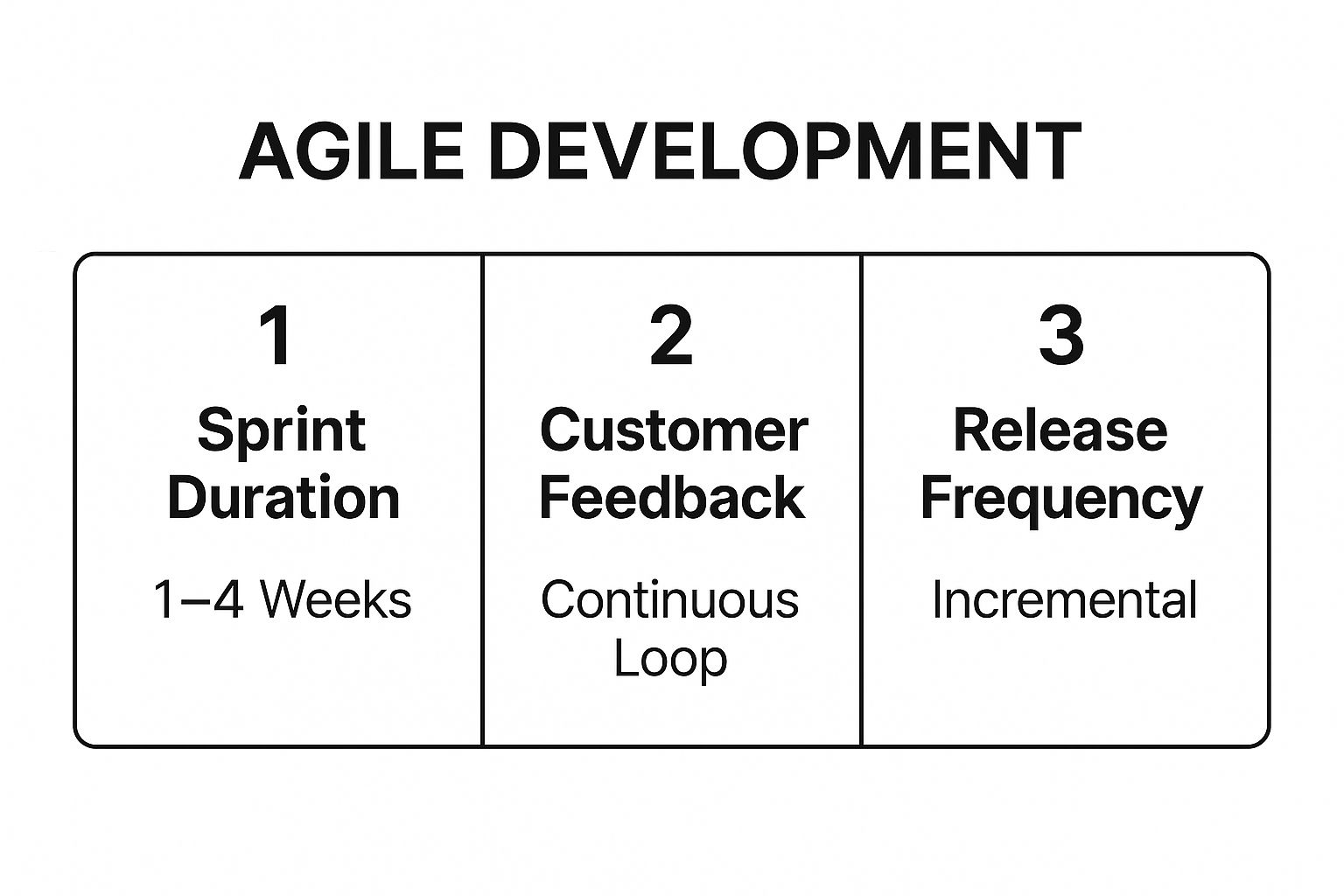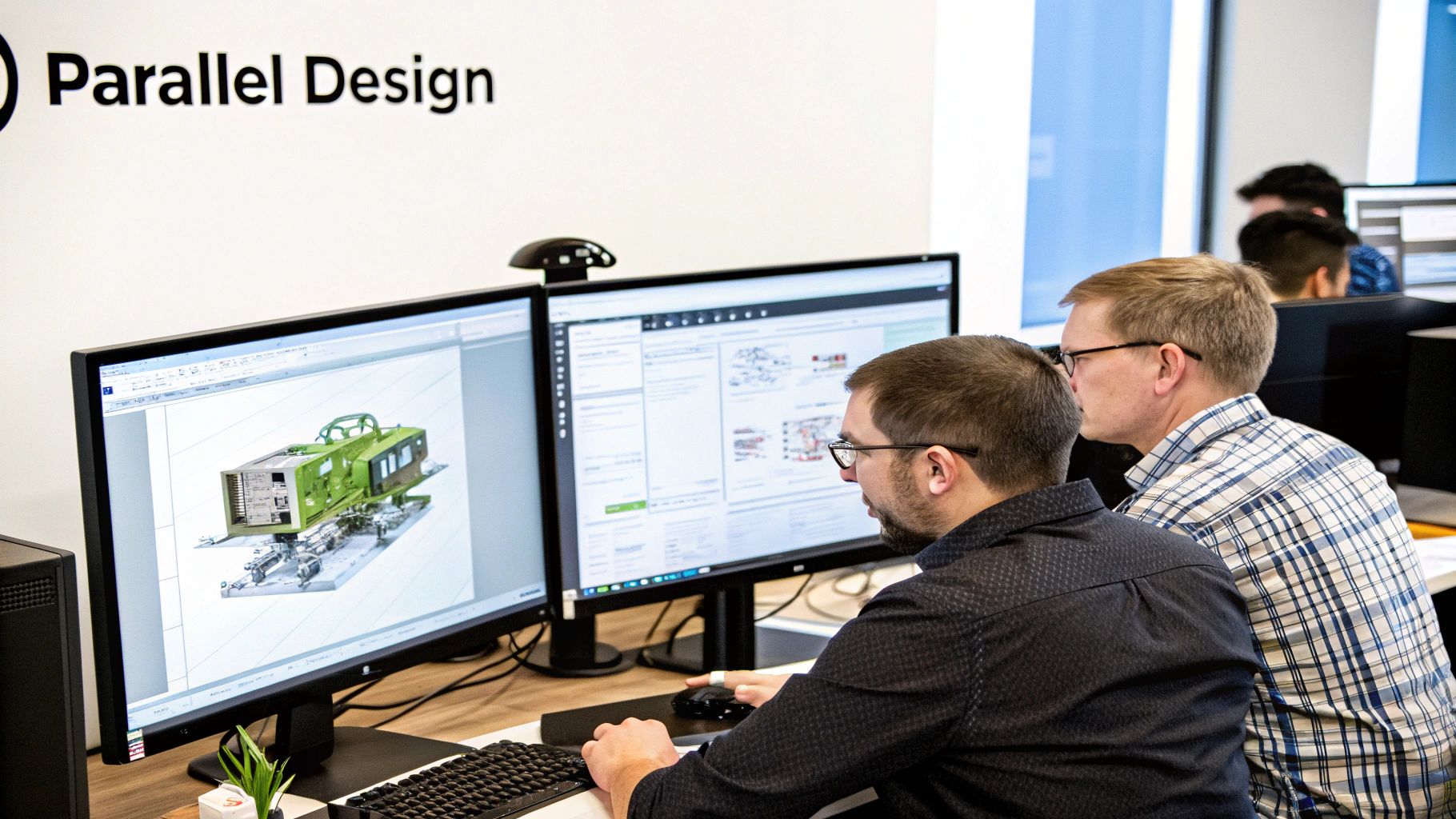In today's competitive market, the gap between concept and customer is shrinking. The ability to launch products and services quickly isn't just an advantage; it's a core necessity for survival and growth. Reducing time to market has become a critical benchmark for success, allowing businesses to capture fleeting opportunities, respond swiftly to customer needs, and consistently outmaneuver competitors. However, achieving this speed requires more than just working harder or longer hours. It demands smarter strategies and fundamentally more efficient processes.
Successfully shortening your product lifecycle involves a deliberate shift in methodology. For instance, understanding real-world acceleration is key; learn how a SaaS platform was launched in just 6 weeks with efficient strategies that prioritize speed and value. This guide moves beyond theory to provide a curated collection of proven frameworks designed to accelerate your journey from the drawing board to the marketplace. We will explore seven powerful strategies, from Agile development to cross-functional squads, that can transform your operations. Each section offers actionable insights and practical steps to help you launch faster, smarter, and more effectively.
1. Agile Development Methodology
Agile is an iterative approach to project management and software development that helps teams deliver value to their customers faster and with fewer headaches. Instead of betting everything on a "big bang" launch, Agile teams deliver work in small, but consumable, increments. This methodology emphasizes collaboration, customer feedback, and small, rapid releases, making it a cornerstone for organizations focused on reducing time to market.
How Agile Accelerates Delivery
The core of Agile lies in its structure of "sprints," which are short, time-boxed periods typically lasting one to four weeks. During a sprint, a cross-functional team works to complete a small, shippable piece of the final product. This cycle of planning, executing, and reviewing allows for continuous learning and adaptation. If market conditions change or customer feedback suggests a new direction, the team can pivot in the next sprint rather than waiting months to adjust a rigid, long-term plan. This inherent flexibility is what makes Agile so powerful for accelerating product launches.
This infographic summarizes the foundational elements of the Agile cycle.

As the visualization highlights, the combination of short sprints and a continuous feedback loop directly enables frequent, incremental releases.
Practical Implementation Tips
Successfully adopting Agile requires more than just following a new process; it demands a shift in mindset.
- Start Small: Begin with a single pilot project to learn the ropes before attempting a full organizational rollout.
- Define 'Done': Establish a clear, shared understanding of what it means for a task or feature to be "done." This prevents ambiguity and ensures quality.
- Invest in Training: Proper training on frameworks like Scrum or Kanban for all team members is crucial for a smooth transition.
- Automate Testing: Use automated testing tools to maintain high quality and speed without sacrificing one for the other. This ensures that rapid development doesn't lead to a buggy product.
By embracing this iterative, feedback-driven approach, companies like Spotify and Netflix continuously deploy features and improvements, staying ahead of the competition and meeting evolving customer demands.
2. Lean Startup Methodology
The Lean Startup methodology is a business development approach that prioritizes creating products to meet early customer needs without requiring large initial funding or elaborate upfront planning. By focusing on a "Build-Measure-Learn" feedback loop, this method helps teams launch faster, validate assumptions, and avoid building something nobody wants. It’s a powerful strategy for reducing time to market by ensuring that development efforts are constantly aligned with real customer demand.

As shown in the diagram, this cycle is designed to minimize wasted effort and resources by focusing on rapid iteration based on empirical data.
How Lean Startup Accelerates Delivery
The cornerstone of the Lean Startup approach is the Minimum Viable Product (MVP). An MVP is a version of a new product that allows a team to collect the maximum amount of validated learning about customers with the least effort. Instead of spending months or years perfecting a product in isolation, teams release a core, functional version to a small group of early adopters. Companies like Dropbox famously started with an MVP-a simple explainer video-to gauge interest before a single line of code was written. This immediate feedback allows for quick pivots or perseverance, ensuring development time is spent only on features that customers truly value. Learn more about how to validate a business idea using these principles.
Practical Implementation Tips
Adopting the Lean Startup mindset means shifting from "can we build it?" to "should we build it?"
- Focus on Learning: Prioritize validated learning over being right. The goal is not to execute a perfect plan but to adapt based on real-world evidence.
- Define Clear Hypotheses: Before building anything, clearly state your assumptions as testable hypotheses (e.g., "We believe our target users will pay $10/month for this feature").
- Start with Riskiest Assumptions: Identify and test your most critical assumptions first. This prevents you from building an entire product on a flawed foundation.
- Be Prepared to Pivot: Use the data you collect to make informed decisions. This may mean significantly changing your product's direction (a pivot) to better serve market needs.
By using this methodology, companies like Zappos and Buffer successfully validated their business models with simple, low-cost experiments, allowing them to rapidly scale once they had proven market demand.
3. Concurrent Engineering
Concurrent Engineering, also known as simultaneous engineering, is a systematic approach that integrates different stages of product development to run in parallel rather than sequentially. Instead of handing off a completed design to manufacturing, which then passes it to testing, all relevant teams work together from the very beginning. This method compresses the development timeline by overlapping tasks like design, manufacturing, and testing, making it a powerful strategy for reducing time to market.
This parallel workflow, pioneered by organizations like DARPA and the Japanese auto industry, eliminates the long delays inherent in traditional "over-the-wall" development models. Problems that would normally be discovered late in the manufacturing or testing phases are identified and resolved early in the design stage, preventing costly rework and significant schedule slips.

The visualization above contrasts the linear, time-consuming nature of sequential development with the highly integrated and accelerated concurrent model.
How Concurrent Engineering Accelerates Delivery
The primary advantage of this approach is the dramatic reduction in the overall project lifecycle. By having manufacturing engineers review designs as they are created, potential production issues can be flagged and fixed instantly. Similarly, involving the marketing and sales teams early ensures the final product aligns with market needs, avoiding late-stage feature changes. This proactive collaboration minimizes downstream errors and eliminates entire phases of redesign, directly shortening the path from concept to customer.
For example, Boeing famously used a form of concurrent engineering, employing comprehensive digital modeling, to develop its 777 aircraft. This allowed thousands of engineers across different disciplines to work on the same digital prototype simultaneously, drastically cutting down development time and improving the final product's quality and integration.
Practical Implementation Tips
Transitioning to concurrent engineering requires a strong emphasis on cross-functional communication and collaboration.
- Establish Clear Interfaces: Define how different teams (e.g., design, engineering, marketing) will interact, share information, and resolve conflicts.
- Invest in Collaboration Tools: Utilize shared CAD software, project management platforms, and communication systems to create a single source of truth for all teams.
- Form Cross-Functional Teams: Create dedicated teams with members from all relevant departments to own a project from start to finish.
- Define Roles Clearly: Ensure every team member understands their responsibilities and how their work impacts other functions to prevent bottlenecks and misunderstandings.
4. DevOps and Continuous Integration/Continuous Deployment (CI/CD)
DevOps is a set of practices that combines software development (Dev) and IT operations (Ops) to shorten the development life cycle and provide continuous delivery with high software quality. At its core, DevOps culture and CI/CD pipelines automate the building, testing, and deployment of applications, creating an efficient and reliable pathway from code commit to production. This automation is a key driver for reducing time to market by eliminating manual handoffs and bottlenecks.
The CI/CD pipeline is the backbone of the DevOps approach. Continuous Integration (CI) involves developers frequently merging their code changes into a central repository, after which automated builds and tests are run. Continuous Deployment (CD) extends this by automatically deploying all code changes that pass the testing stages to a production environment. This ensures a constant flow of value to the end-user.
This visualization illustrates how the CI/CD pipeline automates the software delivery process.

As the diagram shows, a seamless, automated flow from code to deployment enables teams to release features faster and more reliably.
How DevOps and CI/CD Accelerate Delivery
By automating the software delivery pipeline, DevOps and CI/CD dramatically reduce the friction between development and operations teams. Instead of large, infrequent releases that are risky and time-consuming to deploy, teams can push small, incremental changes to production multiple times a day. This rapid feedback loop allows for quicker bug fixes, faster feature delivery, and the ability to respond to market changes almost instantly. Companies like Netflix and Etsy leverage this model to deploy thousands of changes daily, maintaining a significant competitive advantage. For streamlining the development and deployment pipeline, particularly in mobile contexts, leverage the power of mobile CI/CD automation to achieve similar results.
Practical Implementation Tips
Adopting DevOps is a cultural shift supported by powerful tools. A well-managed pipeline is a cornerstone of modern creative operations management.
- Start with Simple Automation: Begin by automating one part of the pipeline, such as the build or unit testing process, and expand from there.
- Invest in Comprehensive Testing: A robust suite of automated tests (unit, integration, and end-to-end) is essential to have confidence in automated deployments.
- Foster Collaboration: Break down silos between development and operations teams through shared goals, tools, and regular communication.
- Implement Gradual Rollouts: Use techniques like blue-green deployments or canary releases to roll out changes to a small subset of users first, minimizing the impact of potential issues.
5. Design Thinking and Rapid Prototyping
Design Thinking is a human-centered, iterative process for innovation that uses design methodology to solve complex problems. It focuses on understanding user needs through empathy, extensive ideation, and experimentation. By integrating rapid prototyping, teams can quickly build, test, and refine concepts, making it an essential strategy for reducing time to market.
How Design Thinking Accelerates Delivery
The power of Design Thinking lies in its emphasis on early validation. Instead of spending months developing a product based on assumptions, this approach forces teams to test their ideas with real users from the very beginning. Rapid prototyping involves creating low-fidelity models, mockups, or even simple storyboards to gather immediate feedback. This fast feedback loop allows for quick pivots and adjustments, ensuring that development efforts are focused on features that truly solve a customer problem. This front-loading of user research and testing prevents costly rework late in the development cycle.
By validating concepts before significant engineering resources are committed, companies can avoid building the wrong product and accelerate the path to a market-ready solution. This methodology is particularly effective for navigating uncertainty and creating innovative products that deeply resonate with users. You can learn more about the phases of the design thinking process to fully grasp its structured yet flexible nature.
Practical Implementation Tips
Adopting a Design Thinking mindset requires a cultural shift toward curiosity and experimentation.
- Start with Empathy: Begin by conducting deep user research, such as interviews and observations, to truly understand the user's pain points and context.
- Use Low-Fidelity Prototypes: Create simple, inexpensive prototypes like paper sketches or clickable wireframes to test core concepts quickly without investing significant time or money.
- Involve Diverse Perspectives: Assemble cross-functional teams for ideation sessions to generate a wider range of creative solutions.
- Test Early and Often: Continuously test prototypes with real users to gather actionable feedback. The goal is learning, not perfection.
Companies like Airbnb have used this design-driven approach to transform their user experience and rapidly evolve their platform, demonstrating how focusing on the user first can dramatically speed up the delivery of a successful product.
6. Platform-Based Development
Platform-based development is a strategic approach where businesses build products and services on top of existing platforms, frameworks, or ecosystems instead of creating everything from scratch. This method leverages pre-built infrastructure, tools, and services, allowing teams to focus their efforts on unique features and customer value. By not reinventing the wheel, this strategy is a powerful accelerator for reducing time to market.
How Platform-Based Development Accelerates Delivery
The core advantage of platform-based development is its ability to bypass foundational, time-consuming development work. Building on a robust platform like Amazon Web Services (AWS) for cloud infrastructure or Shopify for e-commerce provides a solid, scalable base from day one. Instead of spending months developing and debugging core functionalities like payment processing, user authentication, or server management, teams can immediately start building the specific application or storefront that addresses their market need.
This approach significantly shortens the development lifecycle. For example, a startup can launch a sophisticated online store in days using Shopify's ecosystem of themes and apps, a task that would otherwise take months of custom development. Similarly, building a complex business application on Salesforce's Force.com platform allows developers to use pre-existing components to deliver solutions much faster than traditional coding methods.
Practical Implementation Tips
Adopting a platform-based strategy requires careful planning to maximize its benefits and avoid potential pitfalls.
- Evaluate Platform Health: Before committing, thoroughly assess the platform's stability, community support, and future roadmap to ensure it aligns with your long-term goals.
- Understand Total Cost: Look beyond initial licensing fees. Consider potential costs related to scalability, transaction fees, and necessary add-ons to get a clear financial picture.
- Focus on Your Unique Value: Allocate your development resources to what makes your product unique. Use the platform for commodity functions and innovate where it matters most. For great examples of how companies showcase their unique value, you can learn more about building a strong business portfolio.
- Plan for Agility: While platforms offer speed, they can also create dependencies. Design your architecture with potential migration in mind to avoid being locked into a single ecosystem indefinitely.
7. Cross-Functional Teams and Squads
Cross-functional teams are small, autonomous groups that possess all the necessary skills to deliver a complete product or feature from start to finish. This model eliminates the handoffs and delays common in traditional, siloed departments. By bringing together experts from design, engineering, marketing, and more into a single unit, these "squads" can make decisions quickly without needing extensive hierarchical approvals, making them a powerful tool for reducing time to market.
How Cross-Functional Teams Accelerate Delivery
The primary advantage of this structure is the elimination of communication bottlenecks. Instead of a request moving sequentially from marketing to design and then to development, the entire team collaborates from day one. This parallel processing of tasks and real-time problem-solving significantly shortens project timelines. Famously pioneered by Spotify, this model organizes teams into squads, tribes, and guilds, allowing for both focused autonomy and broad knowledge sharing across the organization.
This structure breaks down departmental walls, creating a direct line of sight from ideation to launch. When a team has full ownership and all the required expertise, it can iterate rapidly, test hypotheses, and deploy features without waiting for external dependencies, directly accelerating the product lifecycle. Amazon's "two-pizza teams" operate on a similar principle, keeping teams small enough to be fed by two pizzas to ensure agility and clear communication.
Practical Implementation Tips
Transitioning to a cross-functional model requires a deliberate shift in organizational design and culture.
- Define a Clear Mission: Each squad must have a clear, measurable mission and key performance indicators (KPIs). This provides a North Star that guides their autonomous decisions.
- Grant True Autonomy: Teams need the authority and resources to make decisions related to their mission. Micromanagement defeats the purpose of this agile structure.
- Foster Inter-Team Communication: Establish clear channels, like Spotify's "guilds" (communities of practice), for specialists to share knowledge and best practices across different squads.
- Balance Autonomy with Alignment: While squads operate independently, they must remain aligned with broader company goals. Regular check-ins and strategic reviews are essential to prevent teams from drifting in different directions. For more insights on this, you can learn how to improve teamwork in your organization.
By empowering small, dedicated teams with end-to-end ownership, companies like ING Bank have transformed their operations, enabling them to respond to market changes with incredible speed and efficiency.
7-Method Time-to-Market Comparison
| Methodology / Approach | Implementation Complexity 🔄 | Resource Requirements ⚡ | Expected Outcomes 📊 | Ideal Use Cases 💡 | Key Advantages ⭐ |
|---|---|---|---|---|---|
| Agile Development Methodology | Medium: Requires skilled teams and ongoing customer involvement | Moderate: Cross-functional teams, collaboration tools | Incremental delivery, faster time to market, high adaptability | Software projects needing fast iterations and customer feedback | High flexibility, improved team morale, faster risk mitigation |
| Lean Startup Methodology | Low to Medium: Focus on MVP and iterative learning | Low: Small initial investment, lean teams | Validated learning, reduced waste, faster market validation | New product development with uncertain demand | Minimizes risk, promotes continuous learning, cost-effective |
| Concurrent Engineering | High: Complex project management and coordination required | High: Cross-functional teams and advanced communication tools | Shortened development cycles, early issue detection, cost reduction | Complex product development with parallel workflows | Significant time savings, better quality through early integration |
| DevOps & CI/CD | High: Requires cultural change and toolchain setup | High: DevOps expertise, automation tools | Faster deployment cycles, improved reliability and collaboration | Continuous delivery of software at scale | Automation reduces errors, faster bug fixes, improved ops-dev collaboration |
| Design Thinking & Rapid Prototyping | Medium: Needs skilled facilitation and user involvement | Moderate: Diverse teams and prototyping resources | Better user experience, faster concept validation, innovation | User-centered innovation, complex problem solving | Early risk reduction, promotes creativity and fast learning |
| Platform-Based Development | Low to Medium: Depends on platform integration complexity | Low to Moderate: Use of existing platforms and APIs | Rapid development, scalability, reduced costs | Projects leveraging existing ecosystems and frameworks | Speed of development, access to tested components, scalable design |
| Cross-Functional Teams and Squads | Medium: Organizational change and team autonomy management | Moderate: Skilled, versatile team members | Faster decision-making, higher ownership, better customer focus | Product feature delivery requiring autonomy and speed | Enhanced accountability, reduced overhead, innovation-driven teams |
Choosing Your Accelerator: Putting Strategy into Action
The journey toward successfully reducing time to market is not about finding a single, one-size-fits-all solution. Instead, it’s about strategically weaving together the right combination of methodologies, tools, and team structures that fit your unique project, industry, and organizational culture. The strategies detailed in this article, from Agile Development to Cross-Functional Squads, are not isolated tactics; they are interconnected components of a holistic system designed for speed, efficiency, and value delivery.
Adopting an Agile mindset allows your team to adapt to change and deliver value in iterative cycles, while the Lean Startup methodology ensures you are building something customers actually want, preventing wasted effort on unvalidated ideas. Concurrent Engineering dismantles the slow, sequential "waterfall" approach, enabling parallel work streams that dramatically compress project timelines. These foundational frameworks are then supercharged by the technical engine of DevOps and CI/CD, which automates the pipeline from code to deployment, making releases faster and more reliable.
Synthesizing Your High-Velocity Framework
The key takeaway is that these concepts amplify one another. A cross-functional team operating with a Design Thinking mindset can generate and validate ideas through rapid prototyping far more effectively than a siloed department. Similarly, a platform-based development approach becomes exponentially more powerful when supported by a robust DevOps culture. The goal is to move beyond simply adopting a methodology and instead cultivate an organizational DNA that prioritizes momentum and customer feedback.
To begin putting this into practice, consider these immediate next steps:
- Conduct a Process Audit: Identify the single biggest bottleneck in your current workflow. Is it the handoff between design and development? Is it the manual testing and deployment process? Start by targeting the most significant delay.
- Pilot a Single Methodology: Choose one or two complementary strategies to implement on a small, low-risk project. For instance, combine the formation of a single cross-functional team with the principles of rapid prototyping to test the impact.
- Empower Your Teams: True acceleration requires autonomy. Give your teams the authority to make decisions and the tools they need to execute quickly. This trust is the fuel for any high-velocity environment.
Mastering the art of reducing time to market provides a formidable competitive advantage. It means you can respond to market shifts faster, capitalize on emerging opportunities before competitors, and incorporate customer feedback into your product more frequently. This creates a powerful flywheel effect: faster releases lead to more user data, which leads to better product decisions, which in turn fuels more successful launches. In today's fast-paced digital landscape, speed is not just a feature; it is the foundation of sustainable growth and innovation.
Ready to accelerate the creative phases of your project without the overhead? Connect with a curated network of local branding, animation, and design experts on Creativize. Find the specialized talent you need to bring your vision to life faster by visiting Creativize and start building your project's creative dream team today.

